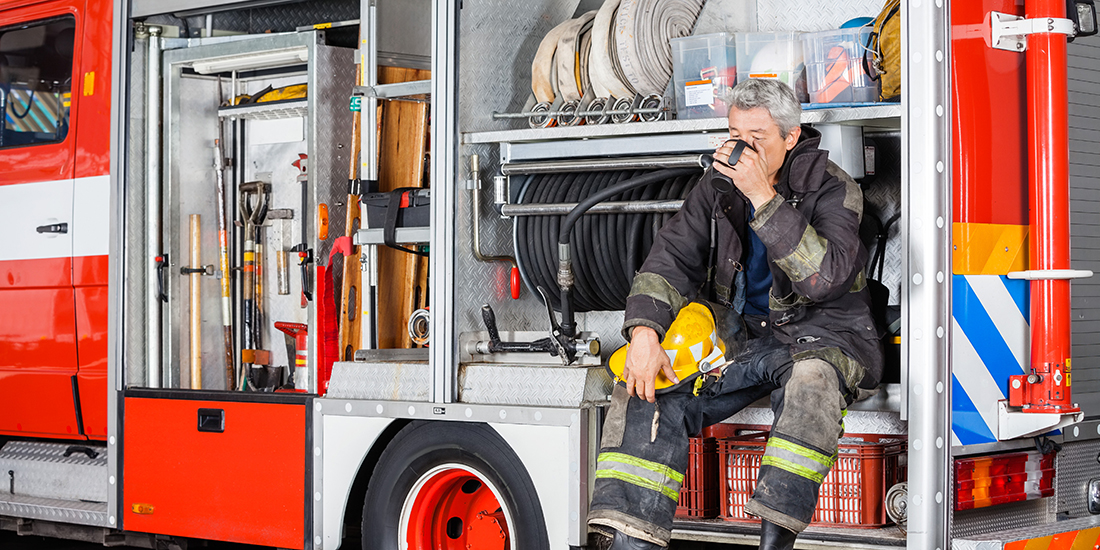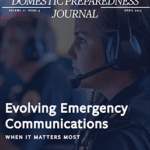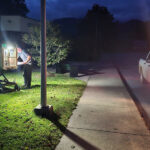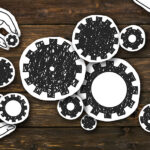First responders and emergency managers work under variable conditions where stress is a common, relentless constant. The demands of their roles—facing trauma, long hours, and high-stakes decision-making—create a perfect storm for chronic stress, leading to alarming rates of unhealthy mechanics and health consequences that include higher rates of cardiovascular disease, chronic diseases, mental health issues, and substance abuse. Additionally, they face a stark contradiction: their ability to care for others hinges on their capacity to care for themselves. These indispensable professionals must take action toward self-care with a proactive, comprehensive approach to well-being.
Chronic stress is not merely a professional hazard. It is a systemic challenge requiring a holistic and strategic response to mitigate the short- and long-term impacts and establish a robust baseline that reacts better to the peaks that might come during responses to crises.
The strategies presented in this article recognize the interconnectedness of stress management, physical fitness, and emotional and mental resilience, as presented by H. L. Thompson in his book The Stress Effect. Thompson, an organizational psychologist and combat veteran, defended the premise that investing in one area of mental, emotional, and physical care yields compounding benefits across all others. These strategies build on evidence-based studies and recommendations from psychology, physiology, neuroscience, and longevity experts to help develop stronger baselines and optimize recovery when necessary.
The A.R.S.E.N.A.L. Strategy: A Foundation for Resilience
Implementing small, consistent actions can create a powerful compounding effect, fortifying and developing a baseline of well-being. An essential mindset shift can make these changes more impactful: prioritizing long-term strategic gains over fleeting, short-term fixes. The strategies presented should be established as a foundational holistic baseline of activities to build resiliency. Additionally, these strategies can be used during crisis and emergency responses to help support mental, emotional, and physical health.
According to Thompson, a strategic “arsenal” for stress management, designed for sustained impact, would include the following.
Awareness. “Know thy self.” Cultivate self-observation. Step back and analyze personal actions, recognizing patterns and triggers. Know the optimal and normal physical and emotional states and states of mind as well as trends and symptoms leading toward abnormal and non-functioning states of mind and emotional performance. “An unaware brain is a surprised brain” (Thompson).
Rest. Prioritize sleep, relaxation, and mindful breaks. Every hour, take a short mental break. Incorporate short physical breaks and walk away from the workstation. Consider incorporating active breaks—such as a simple separation from the working space like a short walk in fresh air or a trip to fill a water bottle. Take time off and protect it as sacred. “A tired brain is a grumpy brain” (Thompson).
Support. Build a positive social network. Stay connected with friends and colleagues. Talk about challenges and victories with someone. Seek professional support from a counselor, guide, or even a support group, as needed. “An unsupported and lone brain is a sad brain” (Thompson).
Exercise. If not already doing so, establish a 60-day exercise program to create a sustainable fitness habit. Find a way to move, sweat, and elevate the heart rate. Incorporate stretching and varied physical activities. Start with sustainable challenges with consistency as the goal. Physical exercise is one of the most underutilized mental, emotional, and performance enhancers. Muscle is the organ for longevity and vigor. “An unfit brain is a tired brain” (Thompson).
Nutrition. Hydrate consistently. Consume “clean,” nutrient-rich foods in appropriate portions. Find a sustainable nutrition program that works. No diet is universally applicable for all. Learn about personal food sensitivities and body responses to allergens to avoid chronic inflammation. “A hungry brain is a distracted brain” (Thompson).
Attitude. Embrace a positive outlook. Practice gratitude, strive for excellence, and take ownership of actions and their consequences. Attitude is contagious—positive or negative—as are feelings. Radiate calmness and positivity to others, and set an example. Get to know personal and team motivators and drives. “A negative brain is an angry brain” (Thompson).
Learning. Foster a lifelong learning mindset. Cultivate genuine curiosity. Keep an open mind about others’ ideas and beliefs. Learn new skills, even if it means starting from scratch. The discomfort of feeling incompetent will pass. An all-knowing attitude closes the mind to new ideas. “Be curious, not judgmental,” as Ted Lasso would say. “An unused brain becomes a forgetful brain” (Thompson).
Tactical Implementation: Specific Strategies for Impact
Beyond the overarching strategy during “blue skies,” specific tools and practices can be integrated into daily routines and during emergency and crisis responses. The following actionable strategies expand on the ARSENAL recommendations.
Sleep Management
Sleep and rest management are two of the most powerful tools to consider for holistic wellness. There are a multitude of small steps that can contribute to better sleep and rest.
Optimize the sleep environment. Colder rooms provide an environment conducive to faster, deeper, and better sleep. Make the room as dark as possible by eliminating any source of light the eyes could see. Making the room dark includes reducing or eliminating exposure to screens at least an hour before bed. If necessary, use a sleep eye mask. Move electronics, including chargers, outside the bedroom.
Establish consistent bedtime routines. Humans are biological creatures of habit. Maintaining and respecting a routine that includes a window of time to get into and out of bed, a hot shower before bed, meditation (or praying), and reading books can significantly remind the body that it is ready to rest.
Prioritize early morning sunlight exposure. Reset the body’s circadian rhythm with direct sunlight exposure. Studies at Stanford University recommend about 10 minutes of direct sunlight exposure at low angles, close to the horizon line, for maximum effect.
Avoid drinks and meals before bed. Coffee stays in the body for about 10 to 12 hours. Calculate how long an afternoon intake of coffee or caffeinated energy drink would take to metabolize before bed. While small amounts of alcohol may facilitate sleep, studies have shown that the quality and depth of sleep phases can worsen and be disrupted (see also Matthew Walker’s 2017 book, Why We Sleep: Unlocking the Power of Sleep and Dreams). Avoid heavy meals that are too close before bedtime to avoid disrupting sleep and rest.
Stress Management
Stress management is crucial for maintaining overall well-being, as chronic stress can negatively impact physical and mental health, relationships, and overall quality of life. By actively managing stress, individuals can improve their physical health, enhance mental resilience, and build stronger relationships.
Physical exercise. Physical exercise is another underrated activity that needs to be more commonly incorporated into daily routines. Any physical activity that leads to muscle activation, movement, increased heart rate, and going outdoors promotes holistic well-being. In addition to helping the body get and stay physically fit, the cardiovascular effects are also measurable in every organ and its functions, including favorable emotional and behavioral impacts. Add protein to a diet to help repair and build muscle after exercise.
Include walks or stationary ways to take active breaks every hour of sedentary work. Include short walks after every meal to support insulin response and improve post-meal glucose responses (see Casey Means and Calley Means’ 2024 book, Good Energy: The Surprising Connection Between Metabolism and Limited Health. Avery). Reach for 7 to 10 thousand steps per day.
To address a hard decision, take a negotiation or brainstorming walk with a small team. Some of the most high-consequence conflict negotiations have used the “take a walk in the woods” strategy to bring about conversational resolutions.
Engaging in group physical activities, such as those found in exercise clubs and on sports teams, also provides additional social support, helping with mental and emotional health. Some sports activities add aspects of mental health, healthy problem-solving, and strategic thinking to friendly competition and social bonding.
Breathing techniques. Breathing is one of the physiological actions that we can control, which directly modifies other biological systems, like slowing down the heart rate. By slowing the heart rate, we can also induce positive effects in our emotional response and focus.
- Physiological sigh: Take a double nasal inhale (a long one immediately followed by a short one), hold for 2 to 4 seconds, and then exhale slowly in a (silent or not) sigh. If necessary, repeat 3 or 4 times. This breathing technique is one of the more effective physiological hacks to voluntarily lower the heart rate and regain control in emotional situations. This technique can be used during an impending intense emotional response, or “amygdala hijacking.”
- Square breathing: This technique is usually recommended as a trick in meditation exercises. It consists of slowly breathing in, holding, breathing out, holding—breathing in a “square” pattern of 3 to 5 seconds each hold. Repeat consistently for 4 to 5 repetitions.
Wearables and Biometrics
Technological gadgets are also a useful resource. Wearable biometric devices, like smartwatches, rings, and continuous glucose monitors, allow easier access to measure and monitor physiological indicators.
Most of these devices connect with smartphones to help interpret metrics that identify the body’s regular averages and provide early warnings when abnormal readings are trending. Some devices could be used to see instant responses to stress (heart rate, skin temperature, heart rate variability), as well as other physiological trends (sleep quality, oxygen saturation, exercise recovery).
Some wearables, like continuous glucose monitors, could be a lifesaving tool by giving early warnings of a dangerous level. Additionally, they can help understand the body’s response to types of food, stress, and exercise. Smart rings monitor sleep quality with more comfort than some smartwatches. Although less accurate than professional, medical-grade monitoring devices, most wearables provide actionable insights into the body’s baseline and trends.
The Power of Proactive Health Investment
Understanding and improving the body’s baseline is a strategic investment in resiliency. Consider investing in laboratory tests to identify biomarkers and sensitivities. Clinical laboratories offer comprehensive laboratory tests with data interpretation that could provide insight into the body’s baseline and help monitor progress under the supervision of trained medical professionals.
 Individuals and organizations should proactively support these practices and provide resources to access them. The result is a workforce better equipped to handle the demands of their roles, resulting in improved performance, reduced absenteeism, and increased retention. Fostering a culture of well-being extends beyond individual benefits. It cultivates a more positive and supportive environment, enhancing team cohesion and strengthening the ability to serve the community effectively.
Individuals and organizations should proactively support these practices and provide resources to access them. The result is a workforce better equipped to handle the demands of their roles, resulting in improved performance, reduced absenteeism, and increased retention. Fostering a culture of well-being extends beyond individual benefits. It cultivates a more positive and supportive environment, enhancing team cohesion and strengthening the ability to serve the community effectively.
Each one of these strategies can lead to small but noticeable changes. A combination of any of these strategies can significantly augment the impact on bodily baselines and capabilities to adapt and overcome adversities. By embracing a holistic and strategic approach, first responders and emergency managers can be empowered to thrive, ensuring they can better support those they protect and care for.

Camilo Olivieri
Camilo “Cam” Olivieri is passionate about empowering first responders and their support structures with action-oriented, evidence-based holistic tools and strategies for mental, emotional, and physical health. Cam is a certified crisis and emergency manager with over thirty years of public- and private-sector experience as a responder, leader, instructor, and consultant. Cam holds several professional certifications as an emergency manager (CEM®, TEM®, CGEMC, MEP, and MEMS), licensed paramedic, and in occupational health and safety (OHST®). Cam has academic degrees in emergency management and industrial and organizational psychology. Additionally, he holds a third-degree black belt in Brazilian jiu-jitsu.
- Camilo Olivierihttps://domprep.com/author/camilo-olivieri







